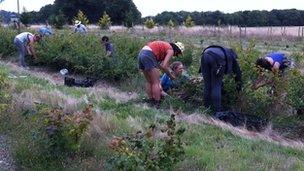How 'gleaners' are helping farmers target food waste
- Published

The farm was left with a glut of redcurrants
The issue of food waste has become a hot topic over recent years, with claims that up to half of the world's food is wasted on the journey from field to fork. The growing gleaning movement aims to make an impact in cutting crop waste by gathering unharvested crops in British fields.
I have fond childhood memories of going to the local "pick your own" farm, getting my hands and knees muddy while searching for the finest British summer fruits fresh from the field.
A few decades later, I found myself standing in a similar field about 30 miles west of London, watching a small team of workers strip glowing redcurrants and lustrous worcesterberries from rows of low bushes in the late August sunshine.
But while PYO customers usually have to pay for the fruit they gather - allowing for a few ripe berries to be popped into a greedy mouth, of course - these people were taking away crates of pristine produce free, and the farmer was perfectly happy about it.
So what's the difference?
In this case the pickers were volunteers from the Gleaning Network, external - a growing movement of volunteers who are called out to farms at short notice by emails or social media sites to gather fruit and vegetables that would otherwise go to waste.
As concern over food waste has grown, most campaigns have focused on the home as the prime source of waste, with more than four million tonnes of edible food being wasted every year by UK households alone.
Some blame also falls on shops and supermarkets, as well as restaurants and other food outlets.
But attention is increasingly turning to farms as a source of waste.
It is difficult to get exact figures on how much edible produce is wasted on farms in the UK, although it is thought to be millions of tonnes.
Over the centuries, agriculture has grown in scale and become increasingly mechanised.
On one vegetable farm I visited, a sophisticated harvesting machine pulled up row upon row of perfect carrots by their tops, gathering hundreds of vegetables every minute.
But around 2% are left in the ground, either because their tops are broken or the machine cannot reach them.
Money down the drain
It may not sound like many, but scaled up over thousands of acres - the typical size of many of today's intensive farms - it can add up to a lot of waste.
For farmers themselves, this is a key issue.
They have seen little increase in the money they get for their crops over the past decade, so any produce wasted is also money down the drain.
But despite many large-scale farmers using the latest technology - such as satellite-guided planting and harvesting - to reduce waste in the fields, there is always going to be a small percentage of crops that remain unharvested, eventually ploughed back into the land.
The cost of labour makes it uneconomical to gather up such a relatively small amount by hand.
On smaller farms, bad planning or poor luck can also lead to crops lingering in the field to rot.

These industrious souls ensure that none of the crop is wasted
The PYO farm I went to was suffering a surfeit of unwanted berries after the unexpectedly hot summer led to a run on strawberries.
While picking those, people tend to grab a few punnets of redcurrants on a whim, but once the strawberries are gone, the customers dry up.
This is where the gleaners come in.
Gleaning is a practice that dates back at least to Biblical times, with the Torah instructing farmers to leave a small corner of their field unharvested for the poor to gather.
This provided a social safety net for the disadvantaged and helped farmers to reduce wastage and get the most out of their fields.
Today's Gleaning Network is part of a growing global movement aimed at getting unharvested crops out of the fields and into the mouths of people that need them.
That might be through food charities such as FareShare, external, large-scale events such as Feeding the 5,000, external, or donating fruit and vegetables to social enterprises to be sold or turned into smoothies.
Food poverty
The gleaners are a mixed bunch: some are students, hippies, or parents looking for a day out with a difference with their bored kids. Others are struggling to feed themselves.
I met one man who said he was living in food poverty and was planning on taking home as many punnets of berries as he could carry to distribute around his council estate in north London.
Everyone certainly seemed industrious, and stacks of full crates of fruit had piled up by the end of the day.
I heard how a previous trip had netted 11,000 cauliflowers - a record haul for UK gleaners - and that groups were being set up across the UK and in France.
These are modelled on the successful networks in the US, such as the Mid-Atlantic Gleaning Network, external, which gather thousands of tonnes of food every year.
As I watched the volunteers tackling the berry bushes in the sunshine, I had to wonder whether such handfuls of well-meaning volunteers dotted around the world could really make a dent in the enormous global mountain of wasted food.
But, just as a beautiful carrot grows from a tiny seed, every great movement starts from a handful of committed people, and attitudes are changing.
The public, businesses and politicians are starting to take notice of food waste as a major issue, signalling that a larger cultural shift could be on the way.
- Published10 January 2013